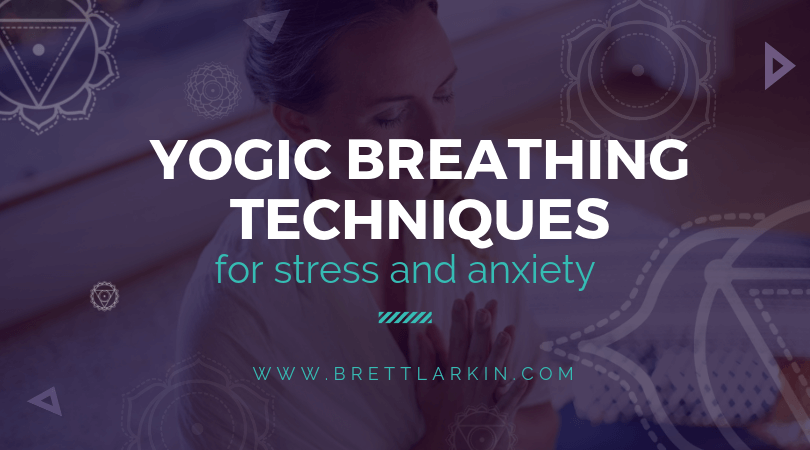
Ever feel stressed or anxious? Yea, me too.
While we may not be able to eliminate stress in our lives, we can learn how to respond to it more effectively. For me, one of the most direct ways to stay centered during times of stress and anxiety is by working with my breath.
Below are some of the breathing techniques – called “Pranayama” in Yoga – that I use regularly in my personal practice to help manage stress and anxiety, and to encourage breath awareness and a sense of calm. I learned these powerful practices in Brett Larkin’s Uplifted YTT program and from Michelle Tate, my acupuncturist and meditation mentor. These breathing exercises build on each other, so I recommend trying them in the order listed.
1. Breath Awareness (Apa Japa)
Apa Japa is a breathing technique of observing the breath. When we get stressed out or anxious, we can sometimes get so wrapped up in our own minds that we don’t even realize how we are breathing. Apa Japa is a great way to check in with your breathing at any time throughout your day. By becoming mindful of your breathing, you may even notice that the breath begins to shift and calm on its own.
Try it:
- Bring your body into a comfortable position. You can be seated, standing or lying down. Lengthen your spine. If you’d like (and it is safe to do so), close your eyes.
- Turn your awareness inward and notice your breathing. Observe the qualities of each breath. Does the air feel warm or cool as it enters and leaves the body? Is your breathing deep or shallow? Where in the body do you feel the breath? Are you breathing rapidly or slowly?
- As you notice different aspects of the breath, do your best not to label or judge anything as good or bad. Just let it be. Simply by noticing and observing, your mind becomes more focused and connected to the present moment.
2. Full Complete Breath
The feelings of tension, urgency and uncertainty that can accompany stress and anxiety often cause the breath to become shallow and concentrated in the upper chest. The belly pulls in with the inhale and goes out with the exhale, and this type of breathing can actually amplify feelings of stress and anxiety!
Conversely, when taking a Full Complete Breath, the belly expands on the inhale and pulls in on the exhale, allowing the diaphragm and lungs to expand more fully and more oxygen to enter the body. If you are not used to breathing like this, it may be challenging at first, and that’s totally normal. Try a few rounds at a time until it becomes more comfortable.
Try it:
- Place one hand on your belly and the other hand on your chest (optional step).
- As you inhale, fill your belly with air first, then your chest (If your hands are resting on your body, the hand on your belly lifts before the hand on your chest).
- As you exhale, release the air the opposite way, first from the chest and then from the belly (If your hands are resting on your body, the hand on your chest lowers before the hand on your belly).
3. Belly Breathing
Belly Breathing is similar to the Full Complete Breath, except that the focus is mainly on the expansion and contraction of the belly. This pranayama can help you feel more grounded, focused and calm, and help you manage the stressful situations in your life with confidence and grace.
Try it:
- Place one hand on your solar plexus, which is the space between your breastbone and navel.
- As you inhale, expand the belly out as far as is comfortable. Feel the belly press into the palm of your hand.
- As you exhale, contract the belly, pulling your navel back towards your spine. Feel the palm gently press into the belly.
*Optional visualization: Life force energy, or Prana, travels on the breath. If you’d like, visualize peaceful energy traveling into your body with each inhale, and anxious energy dropping down and out of your body with each exhale.
You Might Also Like: 3 Tips to Master Ujjayi Breath (An Ancient Yogic Breathing Technique)
4. Alternate Nostril Breathing (Nadi Shodhana)
Alternate Nostril Breathing (Nadi Shodhana) calms the nervous system and, as Brett says, is the “ultimate breathing practice to balance our energy.” This breath alternates between the left and right sides to cleanse the energetic pathways that run throughout the subtle body.
Try it:
- Using your right hand, curl in the index and middle fingers (if more comfortable, you can also curl in the ring finger).
- Bring your thumb to the outside of your nose. Gently press the side of the nose to close off the right nostril. Exhale through your left nostril.
- Keeping your hand where it is, inhale through your left nostril.
- At the top of the inhale, close off your left nostril with your ring finger or pinky so both nostrils are closed. Pause here for a moment.
- Release your thumb and exhale through your right nostril.
- Keeping the hand where it is, inhale through your right nostril.
- At the top of the inhale, close off your right nostril with your thumb so both nostrils are closed. Pause here for a moment.
- Release your ring finger or pinky and exhale through your left nostril.
- Repeat Steps 3-8 for as many rounds as you’d like.
5. Square Breathing
Square Breathing, also called Box Breathing, divides each round of breath into four equal parts. As you complete each piece, imagine drawing one side of a square. This is a powerful breath for soothing the mind and easing anxiety.
Try it:
- Inhale for a count of 4.
- Pause at the top of the inhale and retain the breath in for a count of 4.
- Exhale for a count of 4.
- Pause at the bottom of the exhale and retain the breath out for a count of 4.
*Note: The count can be adjusted to fit your breathing capacity.
6. Uneven Breathing (Vishama Vritti)
In Vishama Vritti, the exhale is longer than the inhale. Elongating the exhale activates the body’s relaxation response, shifting the nervous system into “rest and digest” mode (Parasympathetic Nervous System).
Try it:
- Inhale as much as is comfortable, counting the length of the breath. Feel the belly fill up like a balloon, the ribs expand, and the chest lift. Pause at the top of the breath.
- Exhale, letting the chest and ribs contract. Gently pull the navel back towards the spine to expel all of the air from the body. Try making the exhale 2 counts longer than the inhale, and pause at the bottom of the exhale. As you become more comfortable with this breath, you can extend the exhale out even further.
*Note: Some of the pranayama techniques in this post may include breath retention. Do not retain (hold) the breath if you are pregnant or have heart problems or heating conditions.

Sarah Matchen
Uplift Guest Contributor
Sarah is a 200-HR Certified Yoga Teacher. She teaches meditative, breath-centric yoga classes that emphasize slowing down, calming the mind and relaxing the body. She also loves to incorporate yoga props and pose variations into her classes to help make yoga postures more accessible. Sarah lives in Illinois with her husband and their two rescue dogs.
Connect with Sarah on Instagram | YouTube
Experience 3 Training Videos from Inside My 200-Hour Online YTT

YOU MIGHT ALSO LIKE
- What is Kriya Yoga? The Philosophy and Practice
- Uddiyana Bandha: Tapping Into Your Deep Core
- 4 Reasons Hasta Bandha Is Essential To Your Yoga Practice
- Vitarka Mudra: What It Is and How Do You Use It?
- Shakti Mudra: What It Is and How Do You Do It?
- Garuda Mudra: What It Is and How Do You Use It?
- Kali Mudra: What It Is and How Do You Do It?
- Shunya Mudra: What It Is and How Do You Do It?
- Varuna Mudra: What It Is and How Do You Use It?
- Vayu Mudra: What It Is and How Do You Use It?
- Samana Vayu: The Energy of Balance & How to Access It
- Apana Vayu: The Energy of Release & Surrender
- Udana Vayu: The Ascending Wind
- Prana Vayu: The Breath of Vitality
- Vyana Vayu: The Energetic Secret to Flow










